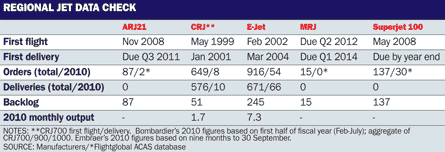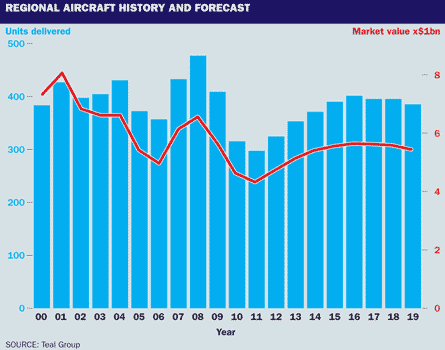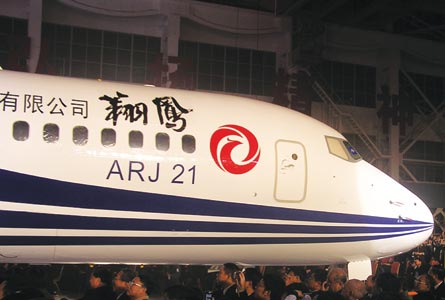For the past few years airframers in Japan and Russia have fought to overcome the stereotype that their new-design regional jets are merely indigenous solutions for local and area carriers, and are incapable of posing meaningful threats to twinjets on offer from industry stalwarts Bombardier and Embraer.
After all, when the regional jet market is discussed or reported upon, Japan's Mitsubishi Aircraft and Russia's Sukhoi have often seen their airliners lumped into a group that includes the home-grown ARJ21, a long-troubled regional jet programme from China's Comac corporation.
|
|---|
Both jets are increasingly viewed as contenders in the regional sector, including by the rivals they seek to trump.
But while the MRJ90 and SSJ100 have gained ground in terms of creditability, one important question remains - will Mitsubishi and Sukhoi be able to secure sizeable firm orders from Western operators in a regional jet market that has flattened out?
Sukhoi is the closest to seeing its dream become a reality. Four prototypes of its PowerJet SaM146-powered SSJ100 are involved in the certification campaign, which "is going very well", says Alessandro Franzoni, chief executive of Superjet International, the Venice-based joint venture between Sukhoi and Italy's Alenia Aeronautica that is spearheading certification and marketing of the aircraft in Western markets.
With 892 test flights - and counting - under its belt, including successful noise testing, the 95-seat jet is on course to receive certification from Russian authorities in November. Delivery of the first of 30 aircraft to Aeroflot is scheduled for December, following by delivery of the first of two SSJ100s to Armenian airline Armavia. But Superjet International has set its sights on placing SSJ100s at airlines in Europe and the USA.
Franzoni says that European Aviation Safety Agency validation will follow Russian certification. "The necessary technical time for EASA is expected to be in the range of few months," he adds.
At the Farnborough air show in July, newly formed Bermuda-based lessor Pearl Aircraft signed a tentative agreement for 30 SSJ100s, with options on 15, and described Italian operator Alitalia as "maybe" a target client.
Alitalia wants to replace its 10 Bombardier CRJ900s and six Embraer 170s, and is scrutinising the SSJ100 against the CRJ900/1000 and the Embraer 190. All three manufacturers have made sales pitches to Alitalia's executives, select employees and top frequent flyers, and await a decision from the carrier.
SuperJet International made another achievement in September when US-based engine lessor Willis Lease Finance agreed firm contracts for six SSJ100s with four options, noting that the aircraft appears to be capable of offering 10% better operating efficiency over competing models.
"These deals are of particular interest for us because they will offer new opportunities for entrance into the US market," says Franzoni, adding that the USA represents "the major SuperJet International market".
Compared with competitors in the same class, the SSJ100 "is undoubtedly superior", he says, pointing to greater comfort due to "wider seats in the configuration three-plus-two, more headroom available, even more space in the luggage compartment and a larger cabin than that of the competitors [E-190 and CRJ900]".
He adds: "The reduction in the noise level during the flight allows a more enjoyable trip," and notes that the SaM146 engine "designed and built specifically for the SSJ100, is able to ensure lower fuel consumption by 10-12% compared with the competitors".
With regard to the SSJ100, Richard Aboulafia, senior analyst with US consultancy the Teal Group, says "there is something there. The product itself looks as though it was designed with reasonable goals and with a lot of international co-operation."
He says it is quite "conceivable" that the SSJ100 will break into the US market. "They are talking to the right audience, and emphasising third-party financing, which is crucial. These guys are on the right track. Will they get there? They'll get somewhere, but the backdrop is a weak regional market."
Mitsubishi, meanwhile, is also pushing forward with its MRJ90 programme. In early September the completed design review of the aircraft. Production started later that month when the first metal was cut by Mitsubishi Heavy Industries for a frame component associated with the horizontal stabiliser.
"MHI and [Mitsubishi Aircraft] continue to devote their utmost efforts to make the MRJ project a success, aiming to play a significant role in the ongoing development of the global aviation industry," says Mitsubishi Aircraft.
First flight is due in the second quarter of 2012, with first delivery to launch customer All Nippon Airways in the first quarter of 2014. In addition to the 15 firm orders from ANA, US regional Trans States Holdings has signed a letter of intent for 50 firm orders and 50 options.
The latter deal represented a coup for Mitsubishi Aircraft when it was signed in October 2009. But one year later the deal has neither been firmed up nor defined by Trans States. It is as yet unclear if the carrier will take the MRJ90, the 78-seat MRJ70 that will come after the larger-capacity model, or a proposed 100-seat stretched variant dubbed the MRJ100X or a mixture of the types.

MARKET TRACTION
Nonetheless, Aboulafia believes the MRJ90 has a shot at gaining some market traction. The E-170/190, CRJ700/900/100 and ARJ21-700 are powered by General Electric CF34 engines. For the MRJ90, "the key enabler" is the 17,000lb-thrust (76kN) PurePower PW1000G geared turbofan engine, says Aboulafia. "Everyone agrees this is a good engine. The jet itself doesn't look to add much value. Originally, it was supposed to be composite, now it's metal. The engine alone makes it [the MRJ90] viable."
By contrast Aboulafia pours cold water on China's ARJ21 programme. Comac had initially aimed for service entry in 2007. Chengdu Airlines is expected to be the jet's launch operator. Comac "aimed low and missed. This was kind of an embarrassment from the word go," says Aboulafia.
He believes Comac would be better off focusing on the 150-seat narrowbody, the C919. "You leave it [the ARJ21] alone and hope somehow the C919 is a happier story. Even if you did fix it, there is no light at the end of the rainbow. The market is not great and even if it were, this looks like a plane designed in the 1960s. You put this down. You walk away and do something more useful."
The market for regional jets has been difficult in recent years due to the global economic slump, and output has slowed. However, the year 2010 has been kinder to regional airframers. Bombardier is now seeing "a steady stream" of orders for its CRJs, "some big, some small", notes Bombardier vice-president commercial aircraft programmes Ben Boehm.
"What I think is also important is the fact that [the backlog] is becoming more diversified. We have more customer interest in the Middle East, more customer interest in South America, but still have the stalwarts in Europe. So we're seeing a diversification of the CRJ market," he says.
Embraer executive vice-president for the airline market Paulo Cesar Silva says the Brazilian manufacturer is also seeing signs of recovery, "of course not strong signs, but we're seeing some signs.
"If you look at our announcements at Farnborough - with Flybe, Republic Airways Holdings, and [Steven Udvar-Hazy's new] Air Lease - we can see that things are getting better. When we look at the world as a whole, we see strong activity in Latin America. It is a market that is growing quite fast, especially Brazil, and then we have Asia, Asia-Pacific and the Middle East, where there is a lot of activity," says Silva.
He points to the deal with UK regional Flybe for 35 firm Embraer jets as being particularly noteworthy. "Flybe was a very important order because Flybe is the largest operator of the [Bombardier] Q400 turboprop. They also operate the E-195. They did an assessment of the E-175 and the Q400 and they concluded that the E-175 is very efficient for the mission that they assessed. That sent a quite strong message to the market," he says.
Neither airframer is counting out its new competitors across the seas, however. "I'm never one to underestimate any competitor, so each competitor is a competitor and I have to be wary of them and I have to watch them closely," says Boehm. He suggests, however, that customers should consider "who has the best economics, who has the best support, which product line has the commonality and gives you the best overall solution".

Source: Flight International

























